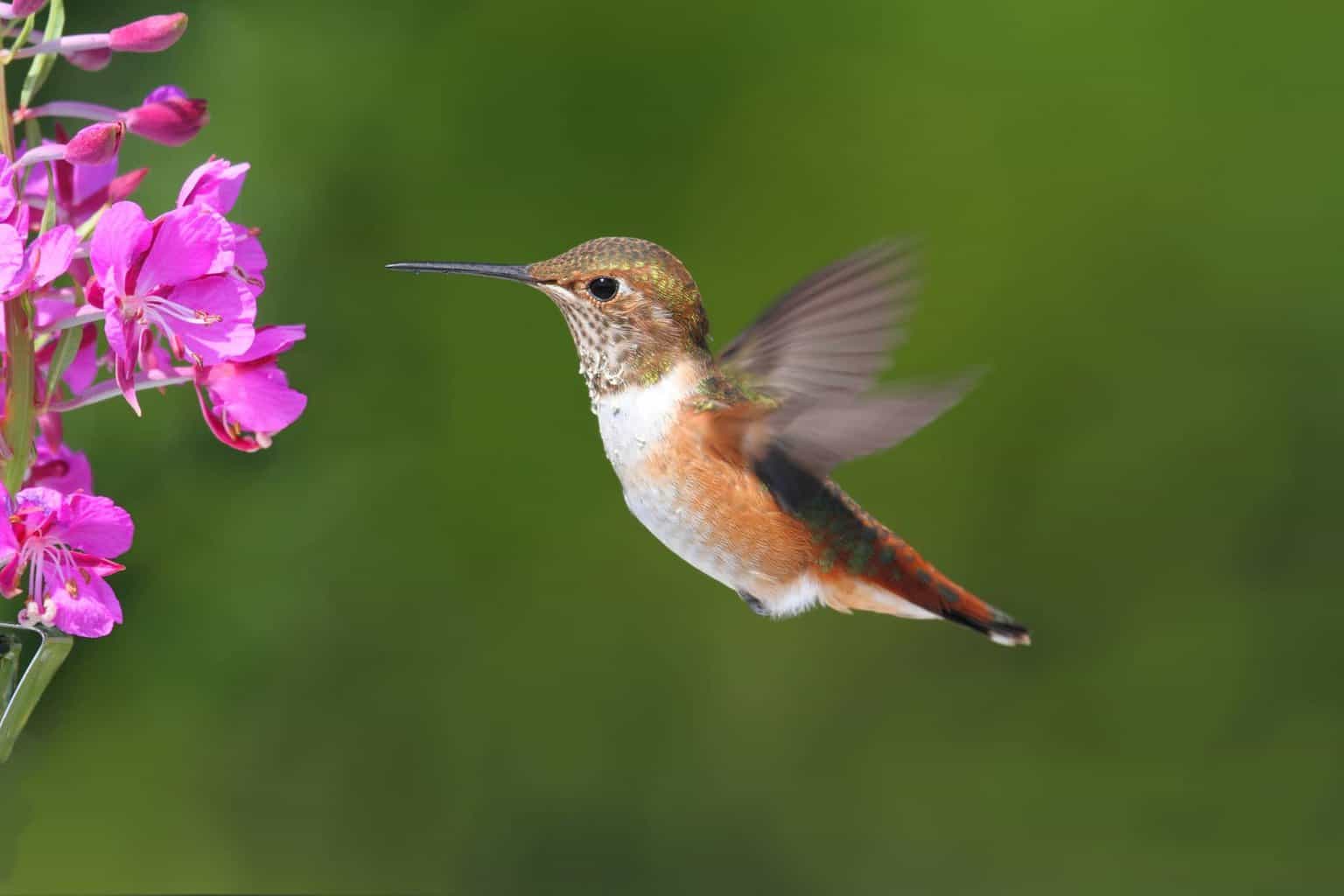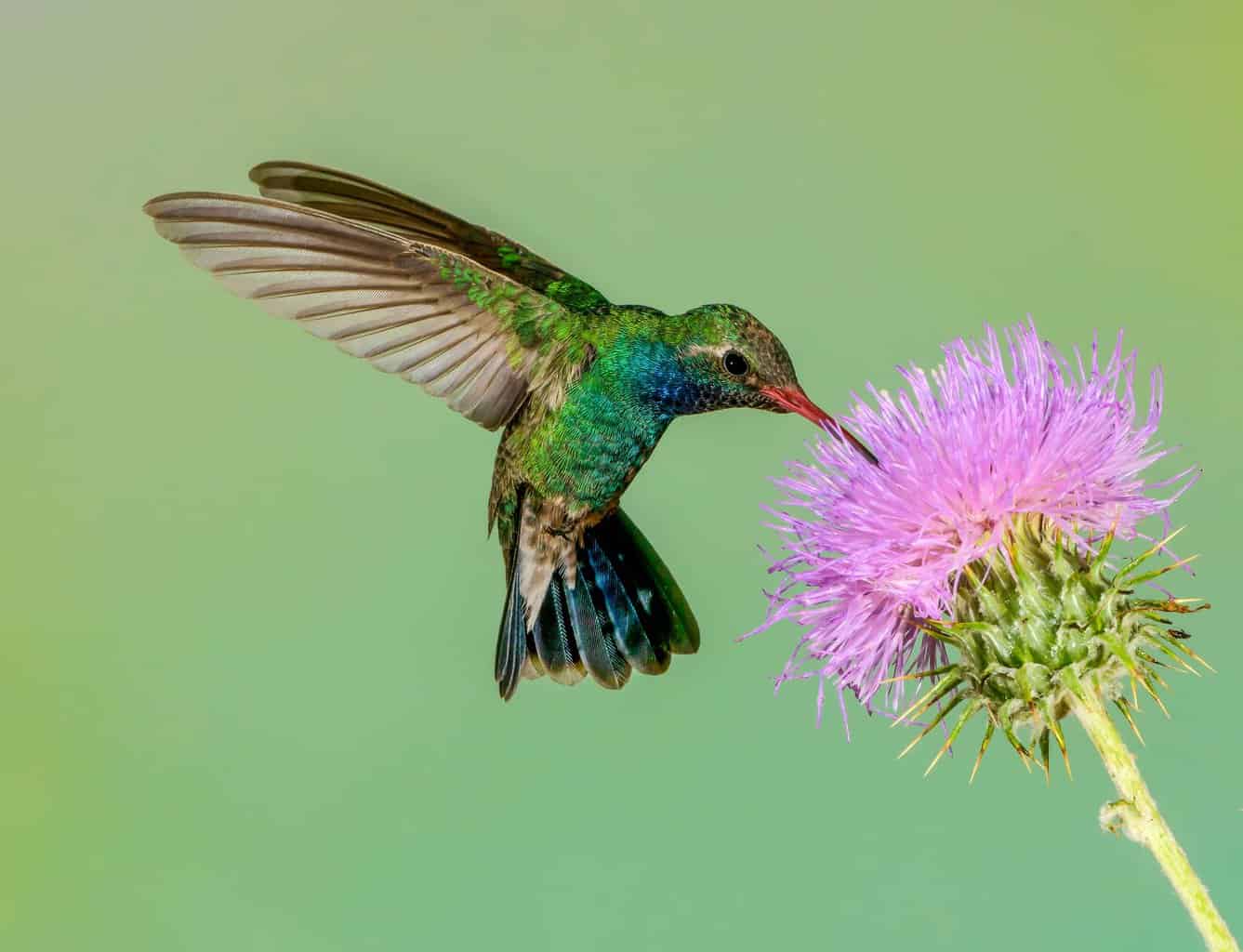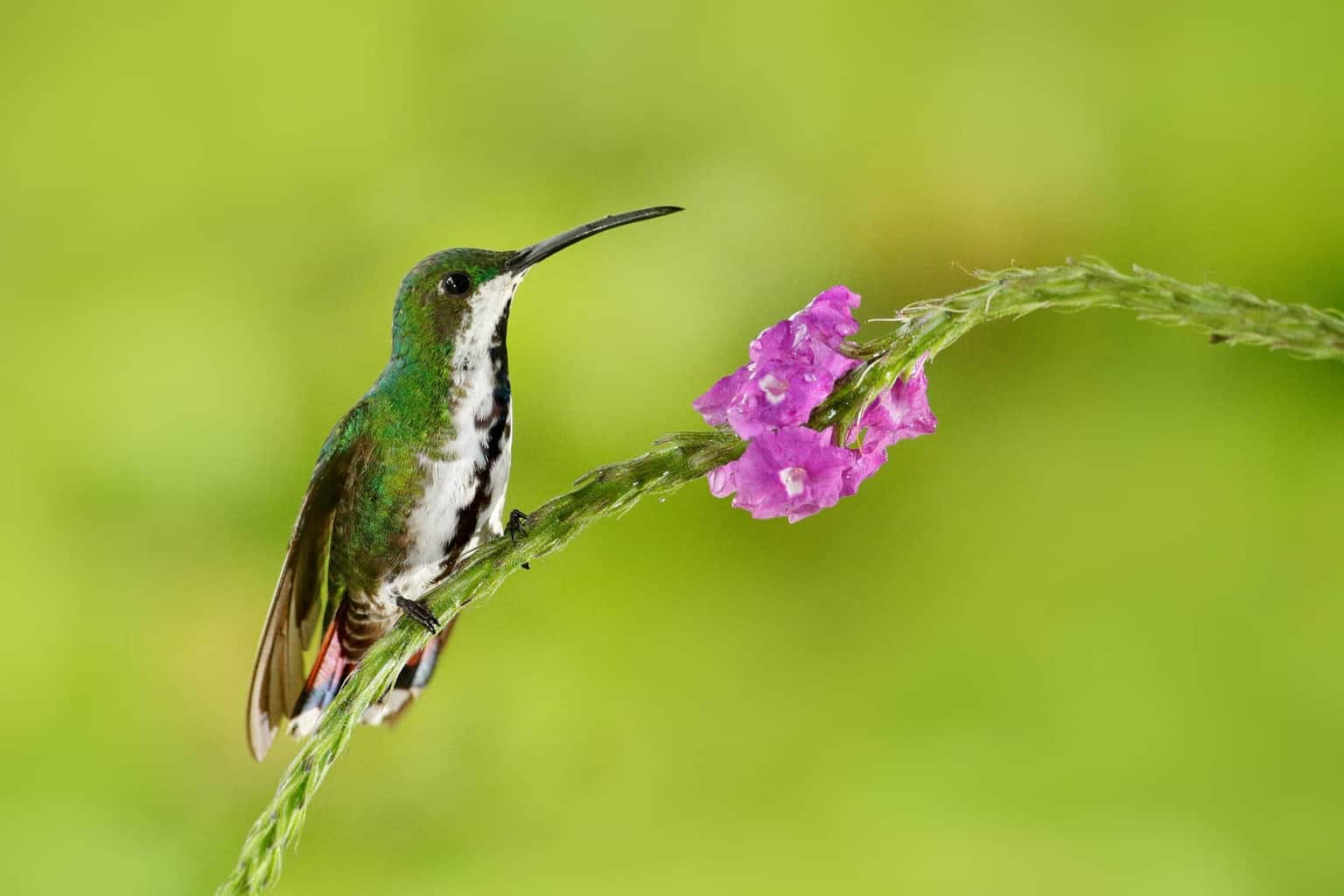Located on the southern coast, Georgia has tropical conditions in the summer, with temperatures ranging from 790F to 820F and rainfall from 44 to 60 inches.
Georgia’s winter temperature range is from 420F to around 520F.
These milder conditions, coupled with the diversity in habitats, create optimal conditions for migratory birds to winter.
The state of Georgia is home to around 420 bird species. Of these species, there are approximately 12 species of hummingbirds found in Georgia.
Georgia’s Hummingbirds, Examples, and Facts
Of the 12 species of hummingbirds found in Georgia, there is diversity in their resident status.
One species can be found at most times of the year in Georgia, while one of the others is only seasonally there, and some have only ever been seen once!
Resident Hummingbirds Of Georgia
There is only one type in Georgia that is a resident.
Ruby-throated Hummingbird (Archilochus colubris)

- Length: 8 – 3.5 inches
- Weight: 1 – 0.2 oz
- Wingspan: 1 – 4.3 inches
Description:
They are emerald or golden-green on the back and crown, with grey to white underparts. Males have a bright red throat while females do not.
Additional Information:
Ruby-throated hummingbirds have a distribution range from the east coast to central Kansas and central Florida to Saskatchewan.
They are found in grasslands, forest edges, open woodlands, and meadows. They also occur in backyards, gardens, and parks.
They are aggressive when competitors come close to their food sources, nectar, and small insects.
There may be a few individuals who have a migration period in Georgia, but most travel to Mexico. This is the only species of hummingbird to nest in Georgia. Their nests can be in trees up to 40 feet high.
Seasonal Visitor Hummingbirds In Georgia
Only one species can be considered a frequent seasonal visitor to Georgia.
Rufous Hummingbird (Archilochus colubris)

- Length: 8 – 3.5 inches
- Weight: 1 – 0.2 oz
- Wingspan: 3 inches
Description:
Male rufous hummingbirds have a bright orange back and belly, with a red throat.
Female rufous hummingbirds have green heads, tails, and backs, with rufous flanks and patches. Sometimes they have an orange spot on their throats.
Additional Information:
Rufous hummingbirds are distributed from the western United States up to Canada and Alaska and are found in forest clearings, shrublands, swamps, and meadows between sea level and 6000 feet.
These birds are highly aggressive, chasing away larger and smaller hummingbird species alike, and their diet primarily consists of nectar and small insects.
Many rufous hummingbirds seem to take their migration pattern to Georgia without going all the way to Mexico during the winter months.
The nests of rufous hummingbirds are built in trees at around 30 feet above the ground.
Rare Visitor Hummingbirds In Georgia
The following hummingbird species include those who only briefly spent a season in Georgia.
Allen’s Hummingbird (Selasphorus sasin)

- Length: 5 inches
- Weight: Around 0.1 oz
- Wingspan: 3 inches
Description:
Males have a copper-colored eye patch, tail, and belly, with a bronze-green back and a red neck. Females have pale copper sides, with a bronze-green back and head.
Additional Information:
Their distribution is mainly in coastal Oregon and California.
One subspecies migrates to Mexico, while the other stays in California as a breeding range.
Allen’s hummingbirds inhabit bushy woods, gardens, mountain meadows, and parks. Their diet consists of nectar and insects.
Anna’s Hummingbird (Calypte anna)

- Length: 9 inches
- Weight: 1 – 0.2 oz
- Wingspan: 7 inches
Description:
A rather drab-looking American hummingbird, they are primarily green-grey, while the male has pink/red feathers on his head and throat.
Females lack the coloration on their neck feathers.
Additional Information:
These hummingbirds are distributed along the USA’s West Coast, from Northern Mexico to Alaska, with the bulk breeding in California.
Their migration is somewhat unique. During winter, they move to lower-lying areas and then return in summer to higher altitudes.
Anna’s hummingbirds inhabit coastal scrub, city parks, gardens, open woods, and savannah habitats, where they feed on nectar and insects.
Black-chinned Hummingbird (Archilochus alexandri)

- Length: 5 inches
- Weight: 1 – 0.2 oz
- Wingspan: 3 inches
Description:
Color-wise, these magnificent hummingbirds are metallic green on their head, flanks, and back. They have grey to white underparts and a black bill.
Males also have a black throat, framed by a thin purple stripe at the bottom. Females lack this black throat, but they do have three tail feathers with white tips.
Additional Information:
In terms of distribution, Black-chinned hummingbirds are widely spread across the western USA, from Canada down to Mexico.
During migrations, most of these birds move south to Texas and Mexico. However, a few are known to move east, especially during the fall months.
Black-chinned hummingbirds frequent various habitats, including canyons, riverbanks, and open woodlands. Their diet consists of nectar and insects.
Broad-billed Hummingbird (Cynanthus latirostris)

- Length: 25 – 4 inches
- Weight: 1 oz
- Wingspan: 5 inches
Description:
The males have a black-tipped red bill and are a rich green, with a blue throat.
Females, on the other hand, have golden-green heads and backs, with a grey underside. They also have a white line behind the eye.
Additional Information:
Their range is in northwest Mexico, however, they occasionally move into the southern USA (particularly in southern Arizona, New Mexico, and Texas).
These birds are commonly found in canyons and mountain meadows up to 9,800 feet.
These birds mostly move a short distance southwards into Mexico during migrations, where they inhabit lowland thorn forests and wetter tropical deciduous forests.
Broad-tailed Hummingbird (Selasphorus platycercus)

- Length: 3.1 – 3.5 inches
- Weight: 1 – 0.2 oz
- Wingspan: 5.25 inches
Description:
Their coloration includes green, primarily above and on the flanks.
Broad-tailed hummingbirds also have a white chest that runs down the belly as a line.
Male hummingbird species have a throat of magenta feathers, while females have green spots on theirs and their cheeks. Females also have a pale ring around their eyes.
Additional Information:
The distribution of broad-tailed hummingbirds is mainly in the southern central states.
Migration routes are generally south into Texas and Mexico, where they frequent pine-oak forests, dry thorn forests, and tropical highlands.
Buff-bellied Hummingbird (Amazila yucatanensis)

- Length: 9 – 4.3 inches
- Weight: 1 oz
- Wingspan: 75 inches
Description:
This species of hummingbirds are relatively large, and, as the name suggests, they are with a buff belly and a red bill, with a dark tip.
Male and female have a bronze-green color on their heads and backs, breasts and throats that are blue-green, and a rufous tail.
Additional Information:
They are commonly distributed between Mexico and southern Texas.
During migration, some birds move south, others stay where they are, and some move northeast into Louisiana.
Their preferred habitats include dense thickets and woodlands, gardens, and open woodlands.
Calliope Hummingbird (Selasphorus calliope)

- Length: 3.1 – 3.5 inches
- Weight: 0.1 oz
- Wingspan: 4.1 – 4.3 inches
Description:
Calliope hummingbirds are green on their backs and heads, but males have a green vest and magenta lines on their throats.
Female Calliope hummingbirds have a peach hue to their underparts.
Additional Information:
Commonly discovered in California to British Columbia during the summer, Calliope hummingbirds migrate into the southwest United States, Mexico, and Central America.
Habitats occupied by Calliope hummingbirds include thorn and pine-oak forests in Mexico and mountain meadows and thickets in the USA.
Green-breasted Mango Hummingbird (Anthracothorax prevostii)

- Length: 3 – 4.7 inches,
- Weight: 2 – 0.3 oz
- Wingspan: 25 inches
Description:
These Green-breasted mango hummingbirds are (relatively speaking) large, and they have tail feathers of orange-red, magenta, or purple with black tips.
Males and female Green-breasted mango hummingbirds have black bills with green bodies. Their flanks and vent are hued with a yellow-brown, and from their throat to the chest is blue.
Additional Information:
In terms of distribution, these birds are generally found in Central America, up to northeastern Mexico. There have, however, been occurrences in the United States including Texas, Georgia, and even Wisconsin.
When it comes to migration, they move a relatively short distance from northeast Mexico southwards.
Their preferred habitats include forest edges and tropical lowland clearings.
Mexican-violetear (Green-violetear) Hummingbird (Colibri thalassinus)

- Length: 8 – 4.7 inches
- Weight: 17 – 0.20 oz
- Wingspan: 7 inches
Description:
Mexican-violetears are medium-sized hummingbirds. Their coloration includes a green head and back, gradually changing to bronze on the rump, and a blue band across the end of the tail.
Those birds found more to the north tend to have a spot on their breast that is violet in color, with a violet-blue chin band stretching from ear to ear.
Additional Information:
Although the primary distribution is in Central America, there are many vagrants which appear in Texas, through the United States (Georgia included) up to Canada.
Habitats frequented by these hummingbirds include forest edges and clearings. Their diet consists of nectar and insects.
Magnificent (Rivoli’s) Hummingbirds (Eugenes fulgens)

- Length: 3 – 5.5 inches
- Weight: 3 oz
- Wingspan: 1 inch
Description:
Males have green backs and heads, with dark (black) underparts and tails.
They have purple crowns and throats that are emerald.
Females are generally green above and grey below. Both males and females have a mark behind the eye that is white.
Additional Information:
Their typical distribution is from Western Panama in the south to southwestern United States (Arizona and New Mexico) in the north. They have been observed in the state of Georgia.
This species migrates over short distances, most likely more of a seasonal change in elevation.
Their preferred flowers include Agave Guadalajara, Castilleja, firecracker bush, and sage.
Conclusion
There are only two frequently found species in Georgia, the Ruby-throated hummingbird, and the Rufous Hummingbird.
All of the other species which have been spotted are generally vagrants or very infrequent visitors to the state.
This, however, can change as temperatures increase, and so will distribution patterns.
Many people have already noticed a shift in species ranges.
The Rufous hummingbird seems to be increasing in its population (or at least increasing in the frequency that people find them), which may be a sign of the times and things yet to come.

